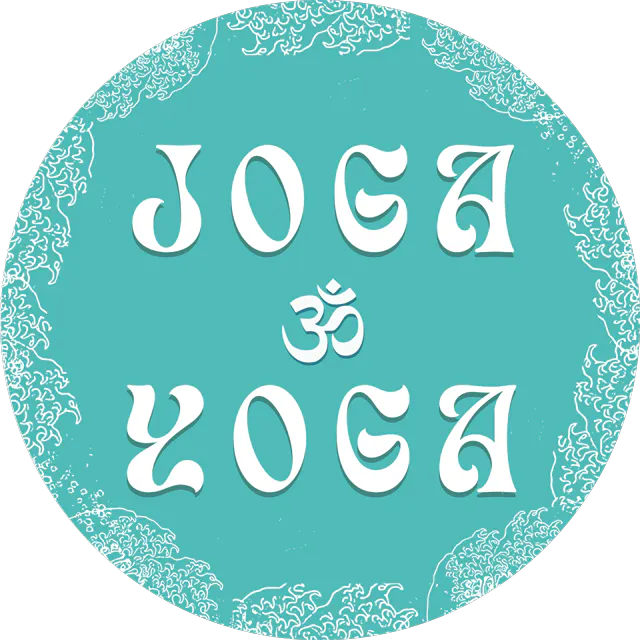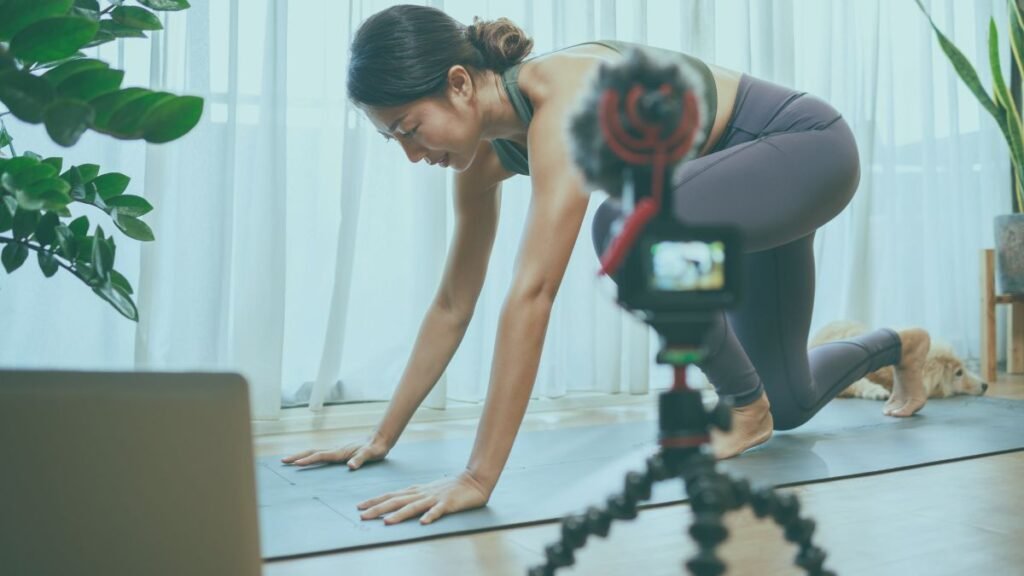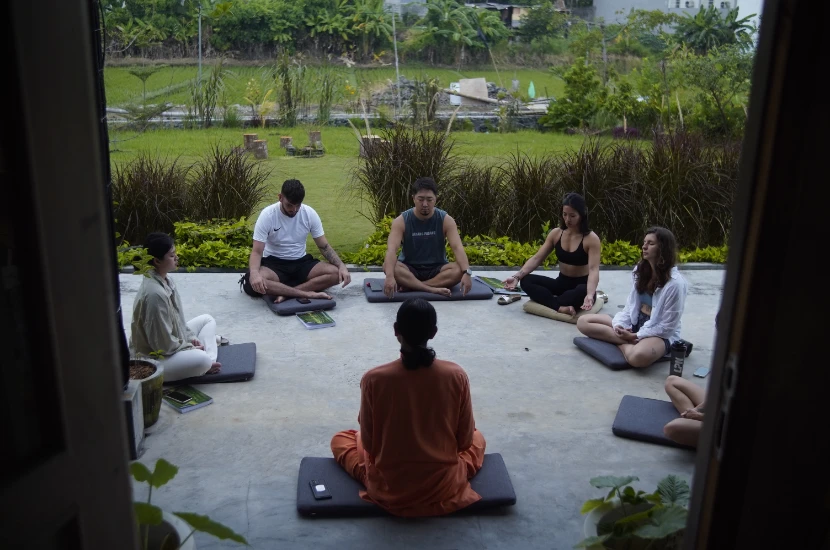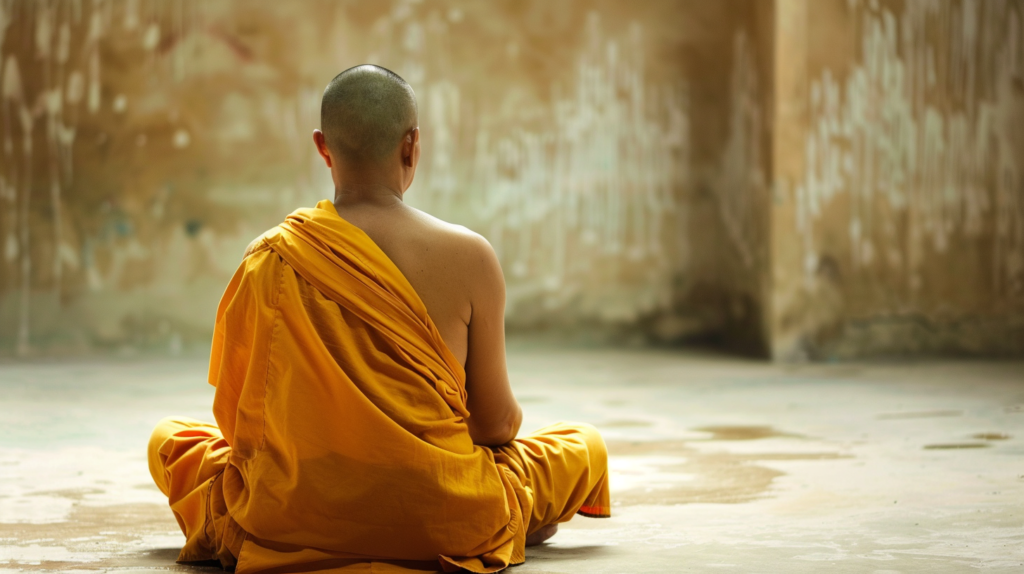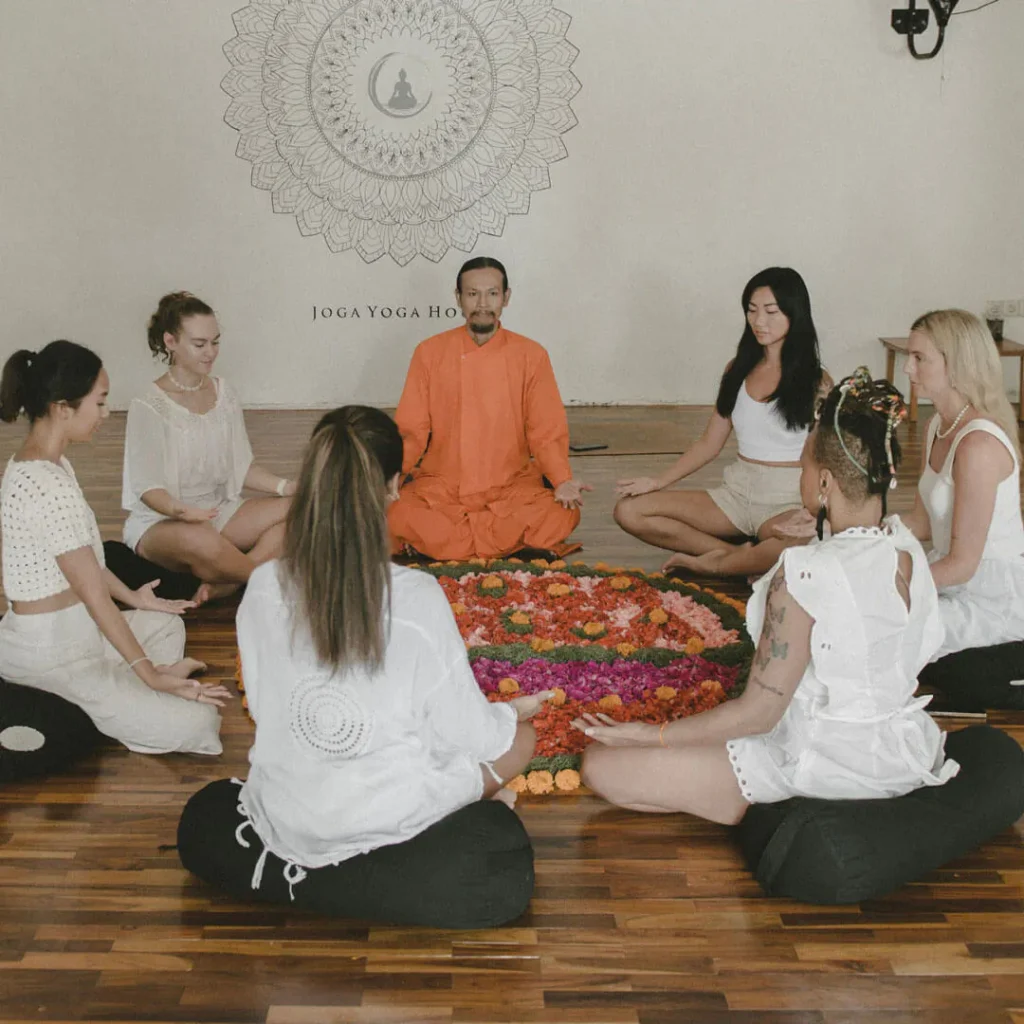What Is Bird of Paradise Pose?
Bird of Paradise Pose, known in Sanskrit as Svarga Dvijasana, translates to “twice-born in paradise.” The name reflects both the visual elegance of the posture and the spiritual symbolism embedded in its form, a standing, bound pose that resembles the long neck and open petals of the tropical bird of paradise flower.
In its full expression, Bird of Paradise is a standing balancing pose where one leg is lifted, extended straight upward, and the hands are bound behind the supporting leg. The spine is elongated, the chest is open, and the lifted leg creates a striking vertical line, demanding control, mobility, and confidence.
This pose is commonly taught as a peak pose in vinyasa flow sequences. That means the entire class builds toward this posture through a progression of poses that prepare the hips, hamstrings, shoulders, and core, before culminating in the final bind, rise, and balance. It’s not typically introduced early in a practice or for beginners due to the coordination, strength, and flexibility it requires.
If you’re new to balancing poses or standing binds, practicing foundational movements from Beginner Yoga can help build confidence before attempting advanced transitions like this.

Symbolism and Energy
Beyond biomechanics, Bird of Paradise symbolizes freedom, elegance, and inner growth. The act of lifting into the pose from a grounded bind reflects the yogic path — rising through focused effort while maintaining internal connection. The upright extension expresses balance not just in the body, but in energy and attention. In this way, it mirrors the philosophy of yoga itself: grounded discipline paired with spiritual elevation.
For those interested in the deeper symbolism of postures and energy centers, the Solar Plexus Chakra plays a key role in confidence and core activation, both of which are central to Bird of Paradise.
Benefits of Practicing Bird of Paradise
Bird of Paradise is not just visually impressive, it offers a wide range of physical, mental, and neurological benefits, especially when integrated into a structured yoga practice.
1. Improves Balance and Proprioception
Balancing on one leg while maintaining a complex bind challenges your body’s proprioceptive system, your internal awareness of spatial orientation. This enhances athletic performance, coordination, and injury resilience across other physical activities.
2. Increases Hip and Hamstring Flexibility
To enter and sustain the pose, you must progressively open the hip flexors, inner thighs, and hamstrings. Practicing the posture regularly helps release tension in these areas, which are often tight from sitting, running, or strength training. For a preparatory flow, consider integrating postures from our guide on Yoga for Degenerative Disc Disease — designed to improve spinal support and mobility.
3. Strengthens Legs, Glutes, and Core
The act of lifting your bound leg while standing requires strong engagement in the glutes, quadriceps, and core stabilizers. Over time, this improves lower-body strength, spinal support, and total-body integration.
4. Opens Shoulders and Chest
The bind component of Bird of Paradise stretches and strengthens the shoulders, deltoids, and upper back, helping to counteract the effects of poor posture or desk-bound routines. It also opens the chest and supports deeper breathing. You can also practice complementary poses from Yoga for Posture and Back Pain to develop safer alignment and upper-body extension.
5. Enhances Mental Focus and Calm
Balancing poses like Bird of Paradise naturally sharpen concentration. The complexity of the shape forces practitioners to stay fully present, improving mental clarity and reducing internal distractions. With consistent practice, many report feeling centered, alert, and mentally lighter after attempting the pose.
6. Evidence-Based Mobility Gains
In a 2023 study published in PLOS One, a 16-week yoga regimen improved participants’ balance time, hamstring flexibility, and hip mobility, all of which are critical to executing Bird of Paradise safely and effectively. While the study didn’t focus on this pose specifically, the measurable outcomes align directly with its physical requirements.
Why Bird of Paradise Is So Challenging
At first glance, Bird of Paradise may appear graceful and accessible, but it’s one of the most demanding poses in the modern yoga canon. The complexity lies in the need to coordinate flexibility, strength, balance, and focus all at once.
Requires Simultaneous Flexibility and Strength
You’ll need deep flexibility in your hamstrings, hips, and shoulders, but also enough muscular strength in your standing leg and core to lift and hold yourself upright without collapsing. Unlike passive stretches, this pose is both active and loaded, challenging your mobility under tension.
Demands Shoulder Mobility and Hip Openness
The bind, which wraps one arm under the thigh and reaches back to clasp the opposite wrist or fingers, requires open shoulder girdles and external hip rotation. If either area is tight or restricted, the entire pose may collapse. A consistent practice of binding poses and hip-opening flows helps prepare these key joints.
If you’re just starting to develop shoulder or hip flexibility, the foundational movements in Heart Opening Poses offer a safe way to begin unlocking these areas.
Advanced Coordination and Focus During Transitions
The moment you rise from a forward fold into standing requires extreme coordination. You are balancing on one leg, engaging multiple muscle groups, and mentally tracking alignment all at once. This is why Bird of Paradise is often cued as a peak pose, meaning your entire flow should build up to this moment.
To improve mental clarity during transitions, many practitioners incorporate techniques from Yoga Meditation Techniques into their practice to stay focused and internally calm.
Common Sticking Points
Most students encounter difficulty with:
- Clasping the bind
- Balancing while rising
- Straightening the extended leg
Rather than rushing into the full expression, work step-by-step with modification tools like yoga straps, wall support, or one-on-one adjustments. You can also explore alternatives through Grounding Poses in Yoga to help stabilize and recalibrate during practice.

How to Prepare for Bird of Paradise Pose
Bird of Paradise requires an intelligent sequence that gradually opens and strengthens the body. Below are two focused paths: one for warm-up and mobility, and another for strength activation.
Recommended Warm-Up Sequence
Before attempting Bird of Paradise, warm up with postures that open the hips, hamstrings, shoulders, and spine:
- Sun Salutations (Surya Namaskar) – Full-body activation with flow and breath coordination
- Triangle Pose (Trikonasana) – Strengthens legs and opens the hamstrings and side body
- Extended Side Angle (Utthita Parsvakonasana) – A direct preparatory pose for the bind
- Lizard Pose and Half Pigeon – Deep hip openers that prepare external rotation
- Cow Face Arms and Reverse Prayer – Develop internal shoulder rotation and upper-back flexibility
These poses help gradually introduce the biomechanical patterns required for Bird of Paradise while reducing the risk of strain.
Strength-Building Poses
Once you’re mobile, it’s time to activate the stabilizing muscles necessary to enter and hold the pose:
- Chair Pose (Utkatasana) – Activates the glutes, thighs, and core
- Warrior III (Virabhadrasana III) – Builds leg stability and balance awareness
- Single-Leg Deadlifts (Yoga Variation) – Encourages control in unilateral movement
- Boat Pose (Navasana) – Strengthens the core and improves upright posture under load
Incorporating these strength-focused asanas before attempting Bird of Paradise improves your ability to lift with control, not momentum.
Step-by-Step Guide: How to Do Bird of Paradise
Step 1 – Set Up the Bind from Forward Fold
- Begin in a wide-legged forward fold
- Bend your right knee and wrap your right arm underneath the thigh
- Bring your left hand behind your back and clasp fingers, wrist, or use a strap
Step 2 – Find Your Base and Begin to Rise
- Shift your weight onto your left leg
- Engage your core and standing leg, using strength to slowly rise
- Keep the bind firm but not tense, and find a steady gaze (drishti)
Step 3 – Straighten the Bound Leg (Optional)
- If stable, begin to straighten the right leg upward
- Keep the spine tall and the shoulders relaxed
- Breathe slowly into the chest and maintain presence
Step 4 – Reverse the Steps to Exit Safely
- Gently bend the lifted leg
- Lower your torso with control back into the fold
- Release the bind and return to neutral
- Repeat on the opposite side
Mastering this sequence may take time, but working through each stage deliberately ensures safe progress and long-term mobility gains.

Modifications and Variations
If you’re working toward the full expression of Bird of Paradise, there are several effective modifications that help you stay safe while building up your mobility and control.
Use a Yoga Strap to Assist the Bind
If clasping your hands behind your leg isn’t accessible yet, loop a yoga strap between your hands. This keeps the bind functional while protecting your shoulders from strain.
Keep the Lifted Leg Bent
Straightening the top leg is not required. Many practitioners hold the pose with a bent knee, especially when focusing on balance and alignment.
Practice the Pose Seated or Lying Down
If balance is a major challenge, try practicing a reclined variation by lying on your back, bending one knee toward your chest, and wrapping a strap around your foot. This lets you simulate the shape and stretch without worrying about falling.
Transition from Bound Extended Side Angle as Prep
One of the most effective progressions is to enter the bind from Bound Extended Side Angle Pose, then gradually rise. This helps your body get used to the bind and the rising action, without doing it all at once. For detailed sequencing that supports bound transitions, explore Mantra & Asana to add deeper layers of focus and intention.
Bird of Paradise Pose Progression: How to Work Up to It
Most yogis won’t land Bird of Paradise in a single session, and that’s okay. A steady progression not only ensures safer practice but also helps integrate flexibility and strength in a sustainable way.
Suggested Training Plan: 2–4 Week Build-Up
- Weeks 1–2: Focus on shoulder mobility, hip openers, and strengthening balance poses
- Weeks 3–4: Introduce binding postures and controlled transitions from standing to folding
Pose Ladder (Sequencing Path)
- Bound Side Angle Pose
- Standing Split
- Half Moon Pose (Ardha Chandrasana)
- Bird of Paradise
This ladder activates similar muscles and joint mechanics, gradually preparing the body for the full posture.

Optional Flows with Goal Tracking
For long-term progress, track your flexibility, balance duration, and bind depth weekly. A printable flow planner with the progression ladder and checkpoints can help. Consider integrating this with your Yoga Teacher Training in Bali if you’re practicing under mentorship.
Common Mistakes to Avoid
Even seasoned practitioners can run into issues with Bird of Paradise. Awareness of common errors helps prevent injury and plateaus.
Pulling Yourself Up with Arms Instead of Using Leg Strength
Relying on the bind to lift yourself can strain the shoulders and compromise alignment. Focus on pressing down through your standing foot and activating the glutes and core instead.
Collapsing in the Chest
A rounded spine reduces stability and defeats the openness of the pose. Keep your chest lifted and your upper back engaged to maintain integrity.
Rushing the Bind or Lifting Phase
Trying to “muscle through” the pose often results in imbalance or falling. Break it into deliberate stages, and only progress once you feel rooted and stable.
Ignoring Hip and Shoulder Prep
Skipping prep work can result in discomfort or stagnation. Always warm up with targeted mobility and stabilization exercises before attempting Bird of Paradise.
Contraindications and Safety Tips
While Bird of Paradise is a powerful pose, it’s not suitable for everyone at every stage. Respecting your body’s limits is essential for sustainable practice.
When to Avoid This Pose
- Shoulder injuries: The bind can overstress rotator cuffs and deltoids
- Tight hamstrings or hip impingement: Forcing the leg into extension may lead to strain
- Vertigo or balance disorders: Standing on one leg while rotating the spine can trigger dizziness
Pre- and Post-Natal Caution
Pregnant practitioners should avoid compressive binds and balancing poses that may affect core stability. Postnatally, return to Bird of Paradise only once shoulder and pelvic floor strength has been reestablished.
If you’re seeking safer strength-building alternatives, explore movements from Is Doing Yoga Better Than Chiropractor? which breaks down effective, safe yoga-based mobility work.
Encourage Awareness of Body Limits
It’s essential to use props, variations, or assistance when needed. The long-term goal is consistency, not forced perfection. Always tune into breath quality and joint feedback as your internal guide.
Related Poses to Explore
These postures support the flexibility, strength, and coordination needed for Bird of Paradise — making them excellent in both prep sequences and cooldowns.
- Bound Extended Side Angle (Utthita Parsvakonasana) – Direct bind transition
- Half Moon Pose (Ardha Chandrasana) – Improves balance and core alignment
- Extended Hand-to-Big-Toe Pose (Utthita Hasta Padangusthasana) – Trains leg extension and control
- Dancer’s Pose (Natarajasana) – Cultivates graceful balance with shoulder opening
Final Thoughts: Patience and Practice in Peak Poses
Bird of Paradise is not a pose you conquer in one session — it’s a direction, not a destination. Each attempt reveals something new about your body, breath, and focus. Whether you bind fully or modify along the way, each stage of this pose deserves celebration.
If you’re working on mobility and joint function, our guide on Yoga for Hip Mobility can complement your training. Or if you want something more playful, even Yoga for Gamers offers mindfulness in motion.
Ready to Go Deeper? Train With Us in Bali
If you’re inspired to take your yoga journey further, the Joga Yoga Teacher Training in Bali offers the perfect environment to deepen your practice. From learning how to cue peak poses like Bird of Paradise to understanding the anatomy and energetic principles behind them, our immersive program provides the foundation you need to evolve as both a practitioner and teacher.
Explore our Yoga Teacher Training in Bali and join a global community committed to transformation.

FAQs About Bird of Paradise Pose
What muscles are used in Bird of Paradise yoga pose?
Bird of Paradise activates the glutes, hamstrings, quadriceps, hip flexors, deltoids, rhomboids, and core stabilizers. It’s a full-body posture that requires both mobility and strength.
Is Bird of Paradise a beginner pose?
No, Bird of Paradise is an intermediate-to-advanced pose due to the demands on flexibility, balance, and coordination. Beginners should focus on preparatory poses and modifications first.
Can you do Bird of Paradise without a bind?
Yes. You can practice a non-bound version by holding your extended leg or using a strap. This still delivers the posture’s benefits while reducing strain on the shoulders.
What yoga poses help prepare for Bird of Paradise?
Poses like Bound Extended Side Angle, Triangle, Half Moon, and Cow Face Arms are all excellent for building the required mobility and body control.
How often should I practice to achieve Bird of Paradise?
Aim for 2–3 focused sessions per week, incorporating preparatory flows, bind drills, and balance training. Progress will vary based on current mobility, but consistency yields results.
